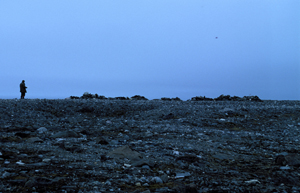 The burial ground on Eolusneset. (Image: Kristin Prestvold / The Governor of Svalbard)
The burial ground on Eolusneset. (Image: Kristin Prestvold / The Governor of Svalbard)
It sometimes happens that the past comes back to knock on your door, and history comes so close that it is almost possible to seize it. Suddenly confronted with past happenings and peoples’ fates, one is plunged into times that were long lost. This is a story of an event like this – in which two people from different centuries met. It is about a short moment when time stood still, and there was no separating the past, the present and the future. All this came from a simple little rest in a very specific place after a long, hard bout of work.
A while ago I was out measuring and drawing up the burial ground on Eolusneset in Sorgfjorden. It dates from the whaling era in Svalbard and consists of 30 graves that lie as silent monuments to the international whaling that took place in the waters of Svalbard in the 1600s and 1700s. Almost 1000 graves from this period of Svalbard’s history can be found along the coastline of the whole archipelago. They tell of a risky workplace where small errors could have fatal consequences, and where the seafarer’s eternal threat – scurvy – haunted everyday life. Prepared for death on their northbound expeditions, the whalers stocked their ships with materials for coffins. Death occurred regularly. It was important to bury the dead on shore and not at sea, if this could possibly be avoided . Like other burial grounds, Eolusneset grew with the years. Throughout the whaling era, the dead seemed to be buried in the same few selected places.
Captain Parry, who found himself in Heclahamna in Sorgfjorden in the summer of 1827 as he attempted to reach the North Pole, has given a good description of the burial ground in Eolusneset. In his account he reflected on the fact that the place must have been frequently visited by the Dutch (who were the first to sail in these waters) in the very early days, when whalers mastered the sea and coast here. Evidence for this, he said, can be found at almost each and every place that they visited, in the form of graves where ”…the bodies are usually deposited in an oblong wooden coffin, which, on account of the difficulty of digging the ground, is not buried, but merely covered by large stones; and a board is generally placed near the head, having, either cut or painted upon it, the name of the deceased with those of his ship and commander and the month and year of his burial” (Conway 1906). Parry found graves on Eolusneset that, according to their inscriptions, dated from as far back as 1738. In Heclahamna, on the other side of the fjord, a single grave was found. The cross was inscribed with the year 1690.
The graves have been well preserved, but the crosses with inscriptions of the names of the dead, their home town and the year, that Parry described, have been lost. On some of the graves, only the base of the cross remains.
It takes some effort to measure and draw 30 graves. A coffee break and a little time to stretch became very necessary after a while. The fog eventually came hovering over me, stretching out over the landscape and blurring all lines so that measuring and drawing became difficult. I unpacked my thermos. My eyes scanned the area for a good place to sit down and rest. I found a collection of rocks on top of the hill towards Eolusneset that would protect me from the weather. It was an ideal place to rest, with its view over the whole of the burial ground, and, had the weather permitted, the whole of the surrounding area. I sat down. My eyes caught sight of a clay pipe in the moss by my feet: someone else had settled on the same rocks as me, and had enjoyed a smoke and a well-earned rest too, many years ago.
Who he was, where he came from, and when he was sat on Eolusneset, I will never know. The only evidence of his existence is a ruined clay pipe in the moss by a burial ground. But from this little fragment of the past, I can be sure that he was a whaler who visited Eolusneset some time in the 1600s or 1700s. He probably came to bury a colleague and a friendAfter the burial he sat down for a short rest somewhere that protected him from the weather, that had a view over the burial ground and the fresh grave. In the protected place, with the rocks as a backrest, he fired up his clay pipe and a last salute was sent to the deceased. While he was sat there, smoking, his clay pipe broke, and the head fell into the moss. There it was found several hundred years later by another person who had sat down for a cigarette and a rest after a long day of work. I took the cigarette with me when I left. But the clay pipe is still there.